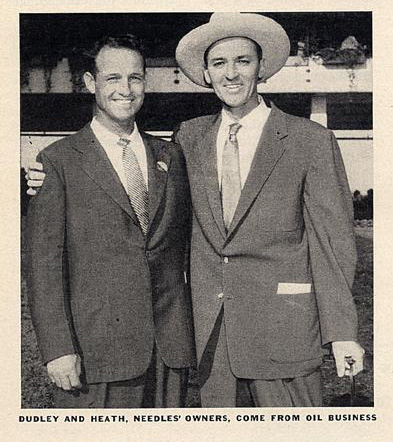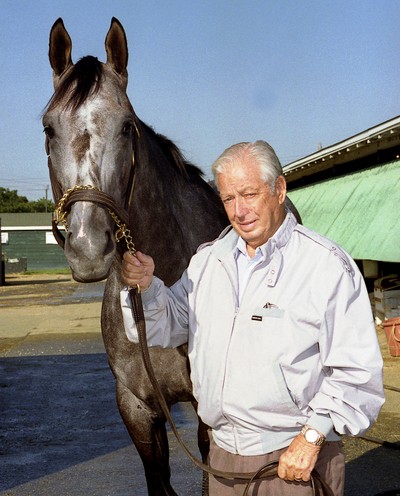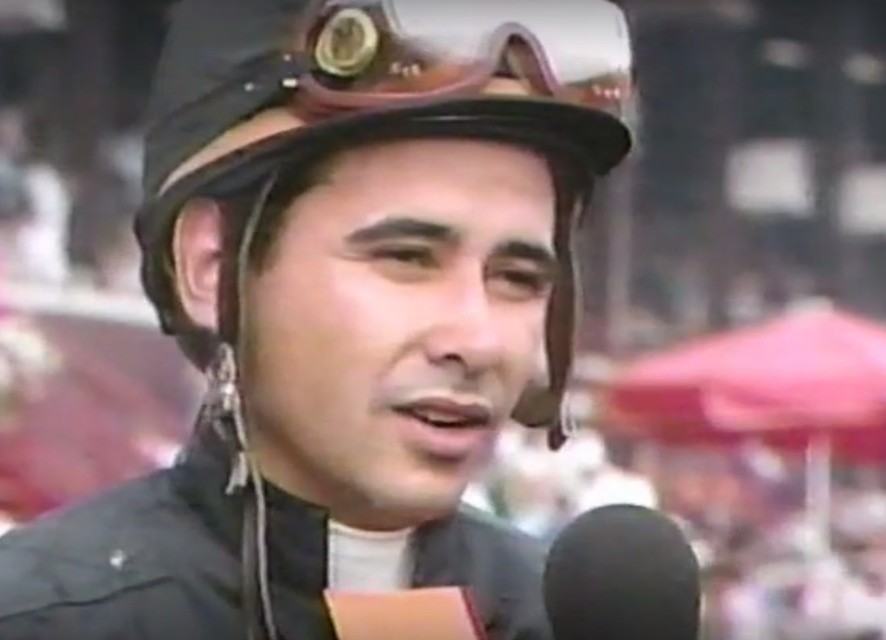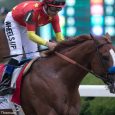This is Part II of the Holy Bull Story. Part I appears below.
High Expectations
With his impressive juvenile campaign came a wave of popularity among racing enthusiasts’ nationwide, along with praise and respect from the media. But Jimmy Croll stayed grounded despite the gray colt’s success, understanding the vagaries of the sport — one that often teaches humility.
“My grandfather was kind of funny about stuff like that,” said Billie Croll. “He was a very low-key, humble man. He wasn’t a bragger. I think he knew Holy Bull was going to be what he was. He was never one to shout it from the rooftops and get ahead of himself. He let the horse prove himself, more than blowing his own horn and saying what the horse was.”
Staying Focused
A strong sophomore campaign debut in the Hutcheson Stakes at Gulfstream Park kept Holy Bull’s connections Classic hopes alive.
“We were very confident that he was going to be a genuine horse,” said Bonnie Heath Jr. “You hope one will become a champion. You never know how good they’re going to be until they start trying graded stakes company. He was the real deal.”
A Temporary Setback
But even the greatest of athletes are vulnerable to not meeting expectations and what appears to be a sense of invincibility on the surface can quickly change for a multitude of reasons. After five consecutive victories, came the unimaginable — a lackluster performance in the Fountain of Youth Stakes at Gulfstream Park.
The Daily Racing Form’s chart said Holy Bull “stopped badly.” He was beaten by 24 1/2-lenghts. The win streak was over and Holy Bull showed he could be beaten. But the big gray had an excuse: he had displaced during the race.
“He got his tongue over the bit, and he had already done that before he went into the gate,” said Smith. “I could hear him. He had never made a noise like that before. And that’s when Jimmy put a tongue tie on him. He never did it again.”
Derby Dreams
But the Bull wouldn’t be denied, and won his next start, the Grade I Florida Derby authoritatively by 5 3/4-lenghts. The Heaths remained in Ocala, as it was the breeding and foaling season, but enthusiastically supported the gray colt from their base in Marion County, Fla.
“We went to OBS to watch the Florida Derby,” said Kim Heath. “There was a lot of screaming going on at OBS.”
Holy Bull added to his legend with a victory in the Blue Grass Stakes, establishing himself as the favorite for the Kentucky Derby.
“We were confident going into the [Kentucky] Derby,” said Kim Heath.
The Triple Crown Trail can be demanding and takes its toll even on the best conditioned athletes. And with only 12 horses having successfully managed to win all three legs, the challenge of staying in peak condition brings its share of adversity. However, when you’re on a horse, one that consistently showed character in the face of difficulty, responding with a resilience of a champion, it’s hard not to have Derby dreams.
“Oh, definitely, you couldn’t help but think that [Kentucky Derby],” said Smith. “He went off as the favorite. That shows you how great he was, and for whatever reason, didn’t run his race that day. He didn’t run horrible. He had beaten that whole bunch before, and many times after, and not only beat them, but beat them with ease. For whatever reason, that day happened. He came back after that race and beat older horses that were much more seasoned and better horses with tremendous ease in the Met Mile.”
But as fate would have it, Smith would get his Kentucky Derby victory — ironically, on a son of Holy Bull — in 2005 with longshot Giacomo.
“We were awfully disappointed he got beat, because I thought at the time, ‘If I’m ever going to win the Derby, this is about the surest thing that you could get.’ It just didn’t happen. It wasn’t meant to be.” said Smith.
From Delirium to Disappointment
But fortunes can change in the blink of an eye, and then something happened — a palpable feeling that something was off, the Bull wasn’t himself the day before the Derby, said Kim Heath.
“Bonnie and I went to the barn,” she explained. “We were there with Jimmy watching the Bull go around the shedrow after he trained. The Bull was always very attentive and looked at everything with a great deal of confidence and no fear.
“He never missed anything. That morning after he trained, he was almost lethargic. He was walking the shedrow with his head hanging, his ears floppy and not paying attention to anything. So, we knew something was up. We couldn’t put our finger on it. Jimmy checked him out and couldn’t find anything wrong with him. It showed the next day in the Derby that something wasn’t right.”
A 12th-place finish, after being installed as the race favorite, left his connections dejected and scratching their heads, like many bettors and racing enthusiasts across the nation who couldn’t understand the outcome of what appeared to be the gray colt’s destiny.
“The press kept on saying he didn’t like the slop,” said Bonnie Heath III. “Well, he loved the slop. The Futurity was in the slop when he beat Dehere. It was knee-deep. Slop never bothered this horse.”
The lackluster performance befuddled those closest to him, as they tried to find a reason for the Bull’s regression.
“Nobody knew. Jimmy didn’t know what was wrong him,” said Kim Heath. “Nobody could figure it out. Dr. Pete Hall couldn’t figure out what was wrong with him, couldn’t find anything and, then, a couple of days later, he was back to himself.”
But the anomaly of Holy Bull’s performance was perplexing and unexplainable, and something that would stay with Jimmy Croll and make an indelible impression, said Billie Croll. It remains a mystery 23 years later, with unanswered questions as to why Holy Bull wasn’t at his best on the first Saturday in May of 1994.
“My grandfather went to his grave saying someone had gotten to his horse that day,” said Billie Croll. “[Holy Bull] emerged, but it made you wonder. He didn’t seem himself the day before the Derby. It was odd, with him being the favorite in the Derby. He didn’t go back to the barn, they didn’t test him or anything after the race, which at the time, my grandfather was too upset at what had happened to realize what had been left out and what had happened.
“He never talked about it. I know in the back of his mind, until the final day, he was pretty much certain that someone had gotten to the horse or something had happened.”
The Run for the Roses, the tension and drama leading up to thoroughbred racing’s most renowned race, and being part of a once in a lifetime occurrence, created an everlasting impression for Billie Croll, one that will never be replicated.
“It was definitely a special time,” she said. “Who doesn’t want to go to the Derby as the favorite? I always say, ‘I could never go to the Derby again after that experience.’ It wouldn’t be the same.”
Next: Holy Bull seeks redemption.
***
Part I

Jackson Curtis Dudley and Bonnie McCoy Heath formed D&H Stable and campaigned 1956 Kentucky Derby and Belmont Stakes winner Needles (photo via Bonnie Heath Farm).
It all started with a phone call.
However, it was one with a lasting impact that touched not only the lives of those who were directly involved, but captured the spirit and imagination of thoroughbred racing fans throughout the nation.
Bonnie and Kim Heath arrived back home in Ocala, Fla., after being at the 1991 January Keeneland Sale. Bonnie made a phone call to his father, Bonnie McCoy Heath, to let him know they were back in town, not knowing what was about to transpire.
The elder Heath and Jackson Curtis Dudley’s D&H Stable campaigned the 1956 Kentucky Derby and Belmont Stakes winner Needles, the first Florida-bred to win the Run for the Roses and the phone call pertained to the younger Heath and his wife taking over the reins of the operation bearing the family name.
“Kim and I had been talking with my dad on and off about running his farm,” said Bonnie Heath III, who acknowledged his father was reticent and certainly not much for small talk and frivolous conversation. “We talked to him for several years about this and kind of forgot about it. When we came back and called him. We’re talking for a second, and he said ‘Let me ask you something, that deal about you and Kim running the farm, do you still want to do it?’”
It had been some time since the Heath couple had given the thought serious consideration.
“I looked across the house at Kim, and I said, ‘I guess so [to his father].’ He said, ‘Good! Be here in the morning.’ He hung up, that’s the way he was, he didn’t say goodbye to anyone. He would just hang up when he was through talking.”
The Birth of a Champion

Hall of Fame trainer Jimmy Croll with Holy Bull (photo via NY Sun).
But that phone call would serve as a harbinger, one so propitious that it would alter their lives forever. It was only four days after the Heaths took on the responsibility of managing the farm that they would begin a sojourn taking them and the world of thoroughbred racing on an unforgettable journey whose historical imprint still resonates powerfully today — one that has created a legacy sure to grow greater with the distance of time.
An extremely tall colt was foaled on Jan. 24, a son of Great Above, out of the broodmare Sharon Brown, whose size at the time, seemed to be the most remarkable quality the future Horse-of-the-Year possessed. Kim Heath had the good fortune of having been there from the beginning, having participated in the foaling of the gray colt.
The Heaths were faced with the challenge of also trying to hire more employees and, at a time when cell phones were more of an exception rather than the rule, communication and convenience had its limitations and restrictions, something that’s hard to entertain and conceive of in today’s world.
When Sharon Brown began to foal, Kim took it upon herself to make sure the delivery was as seamless as possible. The Heaths normally didn’t have anyone living in their barn tack rooms, but good fortune smiled on them on Jan. 24. Kim woke the groom, who was asleep at the time Holy Bull made his way into the world, related Bonnie Heath, Jr.
“She said, ‘Wake up.’ And he said, ‘I don’t know anything about foaling mares.’ She said, ‘I don’t care what you know. I need your strength.’
“The first foot was out and it was big enough that she was probably going to need some help,” said Bonnie Heath III. “And about that time, the maintenance guy came driving in, and he came in, so there were these two guys and Kim.”
Holy Bull’s initial experience with the world, and his first steps, were taken in Ocala, Fla. at Bonnie Heath Farm.
“And here comes Holy Bull and, when he stood up, his withers was in my armpit,” said Kim Heath.
Finding His Way
The gray colt was bred by Rae Carpenter’s Pelican Stable. The Heaths had a unique opportunity, having an intimate window to watch the son of Great Above develop from his nascent stages until leaving for the racetrack as a 2-year-old, to embark on his juvenile campaign.
“He wasn’t a remarkable colt,” said Kim Heath. “He was a little bit aloof.”
There wasn’t anything that distinguished him from the other horses as a yearling, until later that year, continued Kim Heath, who started the yearlings in the middle and end of September in 1992. However, signs of his personality, one that would endear him to a legion of fans, began to surface.
“The first time a rider went up on him, he laid down, said Kim Heath. “It wasn’t out of being a bad boy or anything. He just wasn’t sure what it was, somebody was getting on his back, and he thought, ‘Golly, I’ll just lie down. Maybe they want me to lie down.’ So, that was rather entertaining about him.”
However, his sense of curiosity would belie a professionalism and competitive ferocity that was masked by a playful personality. It was that sense of wonder, an innate part of his character, that enabled him to progress and grow as an athlete and individual. But he brought humor and joy to the lives that he touched — something that was apparent throughout his training.
“I used to ride the pony, and would lead them all through the gate, going and coming off the track,” said Kim Heath. “We were using Tartan Farm’s track because Bonnie’s dad sold that piece to Tartan, retaining the right to use the track.”
It was while leading Holy Bull to the starting gate, that Kim Heath experienced a unique part of the future stakes winner’s personality. It was the colt’s complex curiosity and depth of understanding that took on a greater dimension.
“I was leading the horses through the gate and all the other yearlings went through behind me,” said Kim Heath. “Holy Bull kept staying back. The other horses went on through. It came time for him to go on through and he looked up and topped the gate. He crouched down and scooted through the gate like he wouldn’t fit. He was really big, so maybe he thought he wouldn’t fit.”
Signs of Promise and Professionalism
As his training progressed, so did his evolution, becoming more noticeable as time went on.
“There wasn’t too much of a difference from the other horses — that was until his second run down the lane,” said Kim. “We would let them run down the lane, an eighth-of-a-mile for their first time and, then the next time, in a set, two or three going easy. And the second time, he was stronger than the other horses. The rider really had to hold him.”
Holy Bull began to exhibit the promise you often hear about, but seldom see unless you’re with the horse daily. His potential was becoming more noticeable as he matured, demonstrating the traits that would later stamp him as one of the best horses of his generation.
Bill Croll, Warren A. “Jimmy” Croll’s son, came by the Heath’s farm to watch the racing prospects train, but he never envisioned what he was about to witness.
Holy Bull would be among the horses going to the Hall-of-Fame conditioner’s barn at Monmouth Park that spring. Jimmy Croll had trained champions Parka, Forward Gal, dual Eclipse Award winner Housebuster, Classic winner Bet Twice, stakes winner Al Hattab, the sire of Sharon Brown, and arguably the greatest dirt sire of all-time, the immortal Mr. Prospector.
“We were going to breeze, I think it was a three-eights-of-a-mile breeze, and Holy Bull just drew off and ran several lengths in front of the other horses in the set of three,” said Kim Heath. ”Bill looked at me and said ‘wow’ or something like that. I don’t remember his exact words.”
Leaving the Farm Behind for Life at the Racetrack
Still, although Holy Bull’s precocity suggested talent and potential, until he left the farm for the racetrack, it was hard to know exactly how good he actually was.
When the Heath horses began breezing a half-mile, they were prepared for the next chapter in their lives, one that would find them on the Jersey Shore, in Oceanport, New Jersey, where Holy Bull and his comrades arrived the week after the Kentucky Derby in 1993.
Jimmy Croll was renowned for his reserved nature and humility, so it came as somewhat of a welcome surprise when he breezed Holy Bull at Monmouth Park.
“He called me and said, ‘this is a good one,’” said Kim Heath. “And for Jimmy to say that…”
It was from those early learning experiences that an elite athlete would emerge, and his progression would be mercurial. When Rachel Carpenter bred Great Above to Sharon Brown, the intent was to breed a turf horse. However, a different surface would hold the key to success for the gray horse with the versatile running style.
The colt was renowned for his huge stride, one that he would adjust in his first few jumps out of the starting gate, said Kim Heath.
A Bittersweet Victory
As fate would have it, Holy Bull’s breeder wouldn’t be able to share in his success. Rae Carpenter would pass away the night prior to his maiden bow. But the big gray horse’s connections had an incredibly strong bond with Carpenter and her spirit was almost palpable throughout the son of Great Above’s racing career. The Bull would often be the primary topic of discussion around the Crolls’ dinner table and elsewhere, as the tale of his career began to unfurl. Carpenter would bequeath the Bull to Croll.
“I was at his first race, his maiden race,” said Billie Croll, Jimmy Croll’s granddaughter. “My middle name is Rae. I was named after her [Mrs. Carpenter]. I never actually met Mrs. Carpenter. She was a bit of a recluse. I grew up knowing her name. When Holy Bull broke his maiden, it was an emotional thing for the whole family, with Mrs. Carpenter’s passing.”
It was those early experiences shared by the Croll family that helped strengthen their connection with the Bull, forging an intimate bond, one that can only be understood by those who knew the horse best.
“My father went to see him as a yearling and 2-year-old at Bonnie Heath Farm,” said Billie Croll. “My father came back from that trip and told my grandfather that Holy Bull, out of the entire crop from that year, was going to be the best of the group.”
Any doubts about the Bull’s ability were quickly dismissed with an impressive performance in his debut at Monmouth Park, where he set blistering fractions and won by 2 ½ lengths. But by the time he made his first start, those who were intimately connected with the Bull, weren’t surprised at how easily he won. Jimmy Croll’s comment about the colt provided all of the encouragement they needed to hear.
“[The victory] just kind of bolstered what we thought about him,” said Kim Heath. “We thought he might be a nice colt. What Jimmy said, was the equivalent of Baffert and Lukas being on the front page of the Daily Racing Form. That’s about how understated Jimmy was.”
Beginning of an Everlasting Bond

A young Mike Smith after the 1994 Travers Stakes (photo via ABC Sports).
However, a significant adjustment loomed on the horizon and Croll wanted to match the spirited gray horse with a rider that fit his style — but the jockey he had in mind was committed to another horse. The horseman named to pilot the Bull had established a strong reputation in the Southwest and Midwest and was enjoying success on the tough New York Racing Association (NYRA) circuit, capturing riding titles in consecutive years (1991-92) and setting a record for the number of stakes won during a year in 1992 with 62. Nonetheless, the eventual Hall-of-Famer hadn’t achieved the notoriety that’s now synonymous with his career and the sport of thoroughbred racing. But the decision to select the rider, the one best suited for the Bull, was made by Roberta “Bobbie” Croll, Jimmy’s wife. (Luis Rivera Jr. had ridden the Bull in his victorious maiden race.)
“My grandmother used to brag, because she picked Mike Smith as the rider,” said Billie Croll. “Another jockey was supposed to ride him and they chose a different horse over Holy Bull in his second race. My grandfather was going over jockeys names and kind of [mulling it over] and my grandmother was like, ‘I like Mike Smith. We should put Mike Smith on him.’ She gave Mike Smith the mount on him. He’s a great guy too. He stays in touch with the family. Holy Bull was kind of the culmination of my grandfather’s career and the jump start of Mike Smith’s career. He went on from there. He listened to my grandmother every now and then. She was right for that call.”
Bobbie Croll’s intuition and perceptiveness would pay dividends, uniting a horse and rider to achieve greatness and eventually reach the pinnacle of the sport. However, if things had worked out differently, it would’ve been the 1990 Eclipse Award winning jockey Craig Perret in the irons. A fortuitous set of events had Smith and the Crolls partner a short time earlier with impressive results.
“It was Bobbie,” said Mike Smith, who broke his own record with 66 stakes wins in 1993, 20 in Grade I company, garnering his first Eclipse Award as outstanding jockey. “I was fortunate to ride a horse for Jimmy a few months earlier in New Jersey, and we won the stake. Bobbie just liked the way I rode the horse and got along with it. Craig Perret was supposed to ride but was obligated to another colt in New York. Bobbie said, ‘Let’s use Mike again. I really like the way he rode our last horse.’ That’s how I winded up getting on him. I’ll thank her for that for the rest of my life. The family was great to me. The horse really got my career going. Who knows where I would’ve ended up; he put me on the national map.”
The bond between the horse and rider began to develop from its embryonic stages, with Smith piloting Holy Bull to a 7-length victory in a 6 ½-furlong allowance race at Belmont Park on Sept. 2, a prep for the Grade I Futurity 16 days later, a race he would win over a sloppy track by a half-length, turning back the challenge of the 1993 Eclipse Award 2-year-old champion Dehere. The potential and the promise were evident early during his sophomore campaign, demonstrating a precocity that would continue to evolve as he matured, said Smith.
“Jimmy was so high on him,” said Smith. “But when I was blessed enough to ride him the first time, I knew the kind of ability he had. And of course Jimmy did, and we were all hoping for everything to go well. He stayed sound, and he had some big things to come. We were really looking forward to it. We were always so happy to get to the next race because we knew how good he was.”
Close Connections
The Heaths had the opportunity to be part of the festivities for his next start, the Florida Stallion Stakes’ In Reality Division at Calder Race Course. Holy Bull wasn’t Breeders’ Cup nominated, so he ended his 2-year-old campaign at the Miami Gardens-based racetrack.
“Jimmy and Bobbie were so kind to us, and they included us in everything that they did,” said Bonnie Heath. He and Kim were in the In Reality Stakes win picture. “We were always invited and part of the team. We were able to go to the barn whenever we wanted and that was just wonderful.”
The Heaths and Holy Bull’s paths would be interwoven, enjoying a journey seldom few get to experience. It was after the Florida Stallion Stakes, they decided to send out Christmas Cards from the Bull, a fitting way to cap off his juvenile campaign. Everyone realized how talented Holy Bull was, but they had no idea of what was yet to come…


